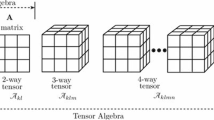Abstract
In this paper, a new method called fuzzy two-dimensional inverse Fisher discriminant analysis (fuzzy 2DIFDA) directly based on 2D image matrices rather than image vectors is proposed for feature extraction and recognition. In the proposed method, the distribution information of samples is first characterized using fuzzy set theory, and the corresponding fuzzy scatter matrices are then redefined. Image discriminant features which have embedded the fuzzy information are finally extracted by selecting 2D principal components and 2D inverse Fisher discriminant vectors. Experimental results on FERET face database and FKP database demonstrate the effectiveness of the proposed method.




Similar content being viewed by others
References
Belhumeur V, Hespanha J, Kriegman D (1997) Eigenfaces vs Fisherfaces: recognition using class specific linear projection. IEEE Trans Pattern Anal Mach Intell 19(7):711–720
Chen CH, Tseng VS, Lee CS (2009a) A genetic-fuzzy mining approach for items with multiple minimum supports. Soft Comput 13(5):521–533
Chen CH, Hong TP, Tseng VS (2009b) Speeding up genetic-fuzzy mining by fuzzy clustering. In: The IEEE international conference on fuzzy systems, pp 1695–1699
Fan ZZ, Xu Y, Zhang D (2011) Local linear discriminant analysis framework using sample neighbors. IEEE Trans Neural Netw 22(7):1119–1132
Friedman JH (1989) Regularized discriminant analysis. J Am Stat Assoc 84(405):165–175
Hastie T, Tibshirani R (1995) Penalized discriminant analysis. Ann Stat 23(1):73–102
Hastie T, Tibshirani R, Buja A (1994) Flexible discriminant analysis by optimal scoring. J Am Stat Assoc 89(428):1255–1270
Hong ZQ, Yang JY (1991) Optimal discriminant plane for a small number of samples and design method of classifier on the plane. Pattern Recognit 24(4):317–324
Hong TP, Chen CH, Lee YC, Wu YL (2008) Genetic-fuzzy data mining with divide-and-conquer strategy. IEEE Trans Evol Comput 12(2):252–265
Kaya M, Alhajj R (2006) Utilizing genetic algorithms to optimize membership functions for fuzzy weighted association rules mining. Appl Intell 24(1):7–15
Keller JM, Gray MR, Givern JA (1985) A fuzzy k-nearest neighbour algorithm. IEEE Trans Syst Man Cybern 15(4):580–585
Kuok C, Fu A, Wong M (1998) Mining fuzzy association rules in databases. SIGMOD Record 27(1):41–46
Kwak KC, Pedrycz W (2005) Face recognition using a fuzzy Fisherface classifier. Pattern Recognit 38(10):1717–1732
Li M, Yuan B (2005) 2D-LDA: a statistical linear discriminant analysis for image matrix. Pattern Recognit Lett 26(5):527–532
Li X, Lin S, Yuan S, Xu D (2008) Discriminant locally linear embedding with high-order tensor data. IEEE Trans Syst Man Cybern Part B 38(2):342–352
Lu JW, Plataniotis KN, Venetsanopoulos AN, Li SZ (2006) Ensemble-based discriminant learning with boosting for face recognition. IEEE Trans Neural Netw 17(1):166–178
Pang Y, Tao D, Yuan Y, Li X (2008) Binary two-dimensional PCA. IEEE Trans Syst Man Cybern 38(4):1176–1180
Phillips PJ, Moon H, Rizvi SA, Rauss PJ (2000) The FERET evaluation methodology for face recognition algorithms. IEEE Trans Pattern Anal Mach Intell 22(10):1090–1104
Phillps PJ (2004) The facial recognition technology (FERET) database. http://www.itl.nist.gov/iad/humanid/feret/feret_master.html
Raudys SJ, Jain AK (1991) Small sample size effects in statistical pattern recognition: recommendations for practitioners. IEEE Trans Pattern Anal Mach Intell 13(3):252–264
Song XN, Zheng YJ, Wu XJ, Yang XB, Yang JY (2010) A complete fuzzy discriminant analysis approach for face recognition. Appl Soft Comput 10:208–214
Swets DL, Weng J (1996) Using discriminant eigenfeatures for image retrieval. IEEE Trans Pattern Anal Mach Intell 18(8):831–836
Tao D, Li X, Wu X, Maybank SJ (2007) General tensor discriminant analysis and Gabor features for gait recognition. IEEE Trans PAMI 29(10):1700–1715
Xiong H, Swamy MNS, Ahmad MO (2005) Two-dimensional FLD for face recognition. Pattern Recognit 38(7):1121–1124
Xu Y, Zhang D (2010) Represent and fuse bimodal biometric images at the feature level: a complex-matrix-based fusion scheme. Opt Eng 49(3):037002
Xu Y, Zhang D, Yang J, Yang JY (2011) A two-phase test sample sparse representation method for use with face recognition. IEEE Trans Circuits Syst Video Technol 21(9):1255–1262
Yang J, Zhang D, Frangi AF, Yang JY (2004) Two-dimensional PCA: a new approach to appearance-based face representation and recognition. IEEE Trans Pattern Anal Mach Intell 26(1):131–137
Yang J, Frangi AF, Yang JY, Zhang D, Jin Z (2005a) KPCA plus LDA: a complete kernel fisher discriminant framework for feature extraction and recognition. IEEE Trans Pattern Anal Mach Intell 27(2):230–244
Yang J, Zhang D, Xu Y, Yang JY (2005b) 2-D discriminant transform for face recognition. Pattern Recognit 38(7):1125–1129
Yang W, Yan H, Yin J, Yang J (2008) Two-dimensional inverse FDA for face recognition. CCPR’08
Yang WK, Wang JG, Ren MW, Zhang L, Yang JY (2009) Feature extraction using fuzzy inverse FDA. Neurocomputing 72:3384–3390
Yang WK, Yan XY, Zhang L, Sun CY (2010) A feature extraction based on fuzzy 2DLDA. Neurocomputing 73:1556–1561
Ye J, Janardan R, Li Q (2005) Two-dimensional linear discriminant analysis. Neural Inf Process Syst 17:1569–1576
Yue S, Tsang E, Yeung D, Shi D (2000) Mining fuzzy association rules with weighted items. In: The IEEE international conference on systems, man and cybernetics, pp 1906–1911
Zadeh LA (1965) Fuzzy sets. Inf Control 8:338–353
Zhang L, Zhang L, Zhang D (2009) Finger-knuckle-print: a new biometric identifier. Proc IEEE Int Conf Image Process
Zhang L, Zhang L, Zhang D, Zhu H (2010) Online Finger-Knuckle-Print verification for personal authentication. Pattern Recognit 43(7):2560–2571
Zheng YJ, Yang JY et al (2006) Fuzzy Kernel Fisher discriminant algorithm with application to face recognition. In: The sixth world congress on intelligent and automation (WCICA06), vol 12(12), pp 9669–9672
Zhuang XS, Dai DQ (2005) Inverse Fisher discriminant criteria for small sample size problem and its application to face recognition. Pattern Recognit 38(11):2192–2194
Zhuang XS, Dai DQ (2007) Improved discriminant analysis for high-dimensional data and its application to face recognition. Pattern Recognit 40(5):1570–1578
Acknowledgments
This project is supported by NSF of China (61005008), China Postdoctoral Special Science Foundation (201104505) and the Fundamental Research Funds for the Central Universities (2010B10014).
Author information
Authors and Affiliations
Corresponding author
Rights and permissions
About this article
Cite this article
Sun, Z., Sun, C., Yang, W. et al. Feature extraction using 2DIFDA with fuzzy membership. Soft Comput 16, 1783–1793 (2012). https://doi.org/10.1007/s00500-012-0861-1
Published:
Issue Date:
DOI: https://doi.org/10.1007/s00500-012-0861-1




